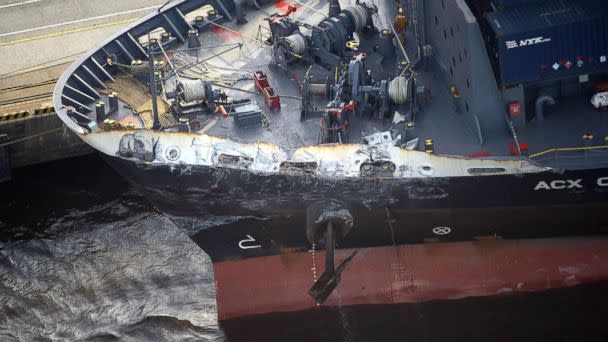
The Japanese coast guard is investigating the collision between the Navy destroyer USS Fitzgerald and a container ship off the coast of Japan on Saturday that killed seven U.S. sailors and injured several more.
Here's what we know:
The collision happened early Saturday
The USS Fitzgerald collided with the Philippine-flagged container ship ACX Crystal off the coast of Yokosuka, Japan, before 2:20 a.m. Saturday local time, according to the U.S. Navy.
The Fitzgerald sustained damage on its starboard side and experienced flooding in some spaces as a result of the collision, according to the Navy.
The destroyer was operating about 56 nautical miles southwest of Yokosuka when it collided with the ACX Crystal. Most of the Fitzgerald's 300 crew members on board would have been asleep at the time, The Associated Press reported.
Weather conditions were clear at the time of the collision, the AP reported. The area is often busy with sea traffic, with as many as 400 ships passing through it every day, according to Japan's coast guard.
The container ship made a sudden turn shortly before the collision
The ACX Crystal's route, provided by vessel-tracking service MarineTraffic, shows that the ship made a sudden turn at about 1:30 a.m., as if trying to avoid something, before continuing eastward.
The ACX Crystal then made a U-turn and returned around 2:20 a.m. to the area of the collision.
It took nearly an hour for the collision to be reported
An official for Japan's coast guard said it is investigating why it took nearly an hour for the collision to be reported, the AP reported.
The coast guard originally said the collision occurred at 2:20 a.m., because when the ACX Crystal reported the crash at 2:25 a.m., it said the collision had just happened. The coast guard later changed the collision time to 1:30 a.m. after interviewing crew members aboard the container ship.
Coast guard officials are trying to get a hold of a device with communication records to further examine the details of the crash, which is also being investigated by Japan's Transport Safety Board.
The U.S. Navy said it is sticking with the 2:20 a.m. timing for the crash, as reported by the USS Fitzgerald.
A spokeswoman for the NYK Line, the ship's operator, agreed with the earlier timing, but she could not explain the 50 minute lag between the collision and its being reported.
The destroyer lost all communications after the collision
Right after the collision, the USS Fitzgerald lost all of its communications because its communications room flooded, a defense official said.
Senior officers had to resort to using satellite phones on the ship, which were the only means of communication available to the ship for some time.
7 sailors were killed
Initially after the collision, five sailors aboard the USS Fitzgerald were reported injured, and seven sailors were reported missing. The remains of the missing sailors were later found in flooded berthing compartments.
The dead sailors were identified as Gunner's Mate Seaman Dakota Kyle Rigsby, 19, of Palmyra, Virginia; Yeoman 3rd Class Shingo Alexander Douglass, 25, of San Diego; Sonar Technician 3rd Class Ngoc T. Truong Huynh, 25, of Oakville, Connecticut; Gunner's Mate 2nd Class Noe Hernandez, 26, of Weslaco, Texas; Fire Controlman 2nd Class Carlos Victor Ganzon Sibayan, 23, of Chula Vista, California; Personnel Spc. 1st Class Xavier Alec Martin, 24, of Halethorpe, Maryland; and Fire Controlman 1st Class Gary Leo Rehm Jr., 37, of Elyria, Ohio.

The victims were killed by the impact or drowned in the flooding, Navy spokesman Lt. Paul Newell said, according to the AP.
Their remains are expected to arrive at Dover Air Force Base in Delaware on Tuesday.
Four sailors and the ship's captain, Cmdr. Bryce Benson, were medically evacuated by a Japanese coast guard helicopter, Cmdr. Richard Gourley of the U.S. Naval Forces Japan said. The 7th Fleet later confirmed that those sailors were in stable condition and were being treated for lacerations and bruises at Naval Hospital Yokosuka.
Benson suffered a head injury in the collision. He was asleep in his quarters at the time and was knocked unconscious by the impact, a defense official said.
Raleigh, North Carolina, resident Mia Sykes told the AP that her son, Brayden Harden, 19, was knocked out of his bunk by the impact of the crash and that water immediately began filling his berth.
He tried to save his shipmates until the flooded berth began running out of air pockets, she said.
Sykes said he told her that four men in his berth died, including those sleeping in bunks below and above him and that three men in the berth above his died as well.
The warship sustained 'extensive' damage
At a news conference Sunday, Vice Adm. Joseph P. Aucoin of the 7th Fleet described damage to the Fitzgerald as "extensive." One side of the destroyer suffered a big gash below the waterline, and three compartments were severely damaged, he said.
"The water flow is tremendous, and so there wasn't a lot of time in those spaces that were open to the sea," he said. "They had to fight the ship to keep it above the surface. It was traumatic."

While the ship will require "significant repair," it is "salvageable," Aucoin said, adding that he hopes the repairs take less than a year.
The ACX Crystal's left bow was dented and scraped in the collision.


The damage to the destroyer suggests that the ACX Crystal slammed into it at a high speed, according to the AP.
What we still don't know
It is unclear whether there were any warning signs before the collision, and authorities have not speculated on the cause of the crash.
Although weather conditions were clear at the time, the fast currents and heavy traffic could have made the area tricky to navigate.
It is also unclear whether the ACX Crystal's sudden turn contributed to the collision.

No comments:
Post a Comment